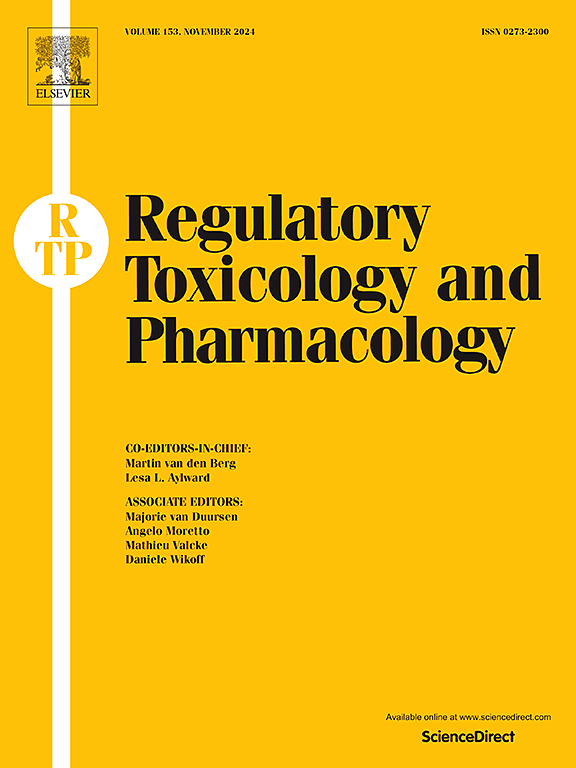Use of NAMs in a weight of evidence approach to evaluate the safety via the inhalation route of acetylated vetiver oil, in spray products
IF 3.5
4区 医学
Q1 MEDICINE, LEGAL
引用次数: 0
Abstract
Acetylated Vetiver Oil (AVO) is a fragrance ingredient. We evaluated the systemic and local toxicity of AVO via inhalation from use of cosmetic spray products.
Systemic exposure after inhalation was calculated using a deterministic 2-Box model. The “local inhalation toxicological threshold of concern” (TTCinh) was used in a weight of evidence (WoE) for the potential of AVO to cause local respiratory toxicity and the in vitro model, MucilAir™ was used to evaluate respiratory irritation.
AVO exposure by inhalation of sprayed cosmetic products does not add significant exposure compared to dermal exposure. The Margin of Safety (NOAEL compared to total systemic AVO exposure) is > 400, indicating no concern for systemic toxicity. Regarding local toxicity, total aggregate exposure to AVO in sprayable cosmetic products is significantly lower than the TTCinh. There were no injurious effects to MucilAir™ tissues by 0.2 % and 1 % AVO. When the NOAEL from the MucilAir™ assay (1 %) and the aggregated exposure were compared, the Margin of Exposure was 137.
In conclusion, based on a WoE approach, the concentrations of AVO used in cosmetic products are not expected to carry a risk of local irritation effects on the respiratory tract or add significantly to aggregate systemic exposure.
在证据权重法中使用NAMs评估雾化产品中乙酰化香根草油吸入途径的安全性。
乙酰化香根草油是一种香料成分。我们评估了通过使用化妆品喷雾产品吸入AVO的全身和局部毒性。吸入后的全身暴露使用确定性2-Box模型计算。在证据权重(WoE)中使用“局部吸入毒理学阈值”(TTCinh)来评估AVO引起局部呼吸毒性的可能性,并使用MucilAir™体外模型来评估呼吸刺激。与皮肤接触相比,吸入喷雾化妆品的AVO暴露不会增加显著的暴露。安全边际(NOAEL与全系统AVO暴露量相比)为bbbb400,表明不存在系统性毒性。在局部毒性方面,可喷雾化妆品中AVO的总暴露量明显低于tth。0.2%和1% AVO对MucilAir™组织无损伤作用。当MucilAir™试验(1%)的NOAEL与聚集暴露进行比较时,暴露裕度为137。总之,基于WoE方法,化妆品中使用的AVO浓度预计不会对呼吸道产生局部刺激作用的风险,也不会显著增加全身暴露。
本文章由计算机程序翻译,如有差异,请以英文原文为准。
求助全文
约1分钟内获得全文
求助全文
来源期刊
CiteScore
6.70
自引率
8.80%
发文量
147
审稿时长
58 days
期刊介绍:
Regulatory Toxicology and Pharmacology publishes peer reviewed articles that involve the generation, evaluation, and interpretation of experimental animal and human data that are of direct importance and relevance for regulatory authorities with respect to toxicological and pharmacological regulations in society. All peer-reviewed articles that are published should be devoted to improve the protection of human health and environment. Reviews and discussions are welcomed that address legal and/or regulatory decisions with respect to risk assessment and management of toxicological and pharmacological compounds on a scientific basis. It addresses an international readership of scientists, risk assessors and managers, and other professionals active in the field of human and environmental health.
Types of peer-reviewed articles published:
-Original research articles of relevance for regulatory aspects covering aspects including, but not limited to:
1.Factors influencing human sensitivity
2.Exposure science related to risk assessment
3.Alternative toxicological test methods
4.Frameworks for evaluation and integration of data in regulatory evaluations
5.Harmonization across regulatory agencies
6.Read-across methods and evaluations
-Contemporary Reviews on policy related Research issues
-Letters to the Editor
-Guest Editorials (by Invitation)

 求助内容:
求助内容: 应助结果提醒方式:
应助结果提醒方式:


